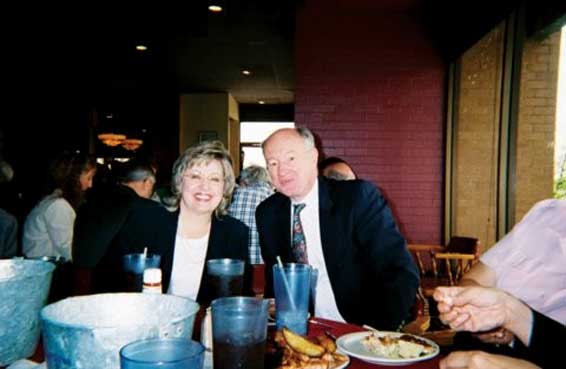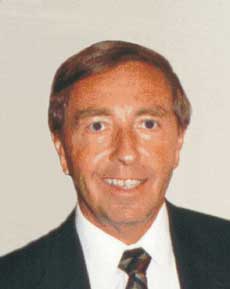 |
| Bill and Merri Jo Gamble |
This particular EMC Personality Profile is different
than any that have appeared in past issues. The difference is
that this issue profiles Bill and Merri Jo Gamble, a married couple
that both have been working in Spectrum Management for over 30
years. Between them they have served over 72 years in this field,
mostly with the Federal Government. Sometimes their work results
in them being on different sides of an issue; this must lead to
some interesting discussions at the dinner table.
Merri Jo started her career with the Federal Bureau of Investigation
(FBI) in 1971 and is now the Spectrum Manager for the Department
of Justice (DOJ). She has over 30 years experience in spectrum
management and has served in a variety of positions within the
FBI, NTIA, and DOJ. In the area of domestic spectrum management,
she is the DOJ representative on the IRAC and co-convener of the
ad hoc group tasked with addressing the national level spectrum
regulatory issues affecting federal, state, and local public safety
interoperability. She has also served as the DOJ representative
to the Spectrum Planning Subcommittee and various spectrum management
ad hoc and working groups under the IRAC.
Currently, Merri Jo is responsible for spectrum planning for the
DOJ, Homeland Security, and Treasury joint tactical land mobile
radio system, the Integrated Wireless Network. Her international
experience includes participation, as a subject matter expert,
on land mobile radio communications that support law enforcement
border issues, in bilateral spectrum negotiations with the Mexican
and Canadian Governments. She participates in activities of the
International Telecommunication Union and individual working parties
tasked with addressing relevant studies in support of land mobile
and fixed communication issues. She was recently a delegate and
U.S. Spokesperson at the World Radiocommunication Conference 2003.
She has also served as a lecturer on land mobile radio communications
system frequency planning at the U.S. Technical Training Institute.
Bill graduated from Bemus Point High School in New York and attended
Dartmouth College where he graduated with an AB degree, with honors
in Engineering Science. He stayed there for a fifth year to obtain
a BSEE from Thayer School of Engineering at Dartmouth College.
While in the Air Force, Bill obtained an MSEE from the University
of Southern California. Finally, while working in Washington,
D.C., he earned an additional year’s credit in electrical
engineering at The George Washington University.
Bill currently is President and the principal employee of Gamble
Telecommunications, Inc., a small consulting firm in the area
of domestic and international spectrum management and regulation.
Much of his effort is committed to participation in numerous study
groups and working parties of the International Telecommunication
Union (ITU), primarily in the area of satellite services, mobile
services and space research services. Domestically, he assists
commercial efforts in achieving coordination with the Federal
Government users of the spectrum in order to accommodate new products
within the U.S. In the ITU Working Party 4A, he obtained a Recommendation
on the characteristics and interference potential of laser systems
in the near-infrared region of the spectrum and is currently working
to gain a consensus on any needed provisions for these systems
within the Radio Regulations of the ITU-Radiocommunication Sector.
Also, he is currently serving as international chairman of ITU
WG 1A-5, which is addressing the current and projected use of
the bands above 3000 GHz and the bands between 275 and 3000 GHz
in preparation for addressing these bands at an ITU World Radiocommunication
Conference. In another effort, Bill is serving as the international
chairman of the Characteristics Working Group of ITU-R Task Group
1/8 which is grappling with recommendations on how to accommodate
Ultra-wideband (UWB) technology. In addition, he is working on
the regulatory status and provisions needed to support the growing
use of unmanned aerial vehicles.
Bill spent nearly five years directly after college in the U.S.
Air Force as an officer at the Rocket Propulsion Laboratory on
Edwards Air Force Base, California. While there, he worked as
an instrumentation engineer on rocket engines with cryogenic and
exotic fuels. He also monitored the electrical and electronic
aspects of a military construction project for a new high thrust
test facility.
Bill started in 1968 with the Office of Telecommunication Management
(OT), and in 1997 retired from OT’s successor, the National
Telecommunications and Information Administration (NTIA), Office
of Spectrum Management (OSM). His primary function at OSM was
chairing the Interdepartment Radio Advisory Committee (IRAC),
the longest standing committee of the Government.
In his first ten years in the spectrum management field, Bill
served in various positions associated with the Spectrum Planning
Subcommittee (SPS) and chaired several IRAC Ad Hoc Groups. For
several years, he was chief of the Systems Review Branch, which
assessed the major radio communication systems submitted to the
SPS for spectrum supportability and made recommendations to that
subcommittee.
After that, Bill chaired the SPS of the IRAC in the period 1978-1984.
In this position, he led the SPS effort to review all major radio
communication systems submitted by the Federal agencies and to
make recommendations to the Deputy Associate Administrator of
OSM. He started and chaired the Space Systems Group of SPS, which
was the focus for the advance publication, coordination, and notification
of Government space systems in the ITU forum and which also reviewed
foreign and commercial space systems for impact on Government
systems.
During the period 1984-1996, Bill chaired the IRAC while serving
as the Deputy Associate Administrator of the NTIA Office of Spectrum
Management. He was responsible for maintaining the Government
Master File of Frequency Assignments (GMF), and for issuing the
monthly CD-ROMs containing these assignments. He served as the
Department Representative to the National Security Telecommunications
and Information Systems Security Committee (NSTISSC), then chaired
by the Assistant Secretary of Defense, C3I. He represented the
civil sector spectrum management interests in the NATO Allied
Radio Frequency Agency (ARFA) civil/military forum and also in
the European Conference of Postal and Telecommunications Administrations
(CEPT) civil/military forum. He was responsible for issuing and
maintaining the NTIA Manual of Regulations and Procedures for
Federal Radio Frequency Management and certified spectrum support
for all new major radiocommunication systems under Chapter 10
of the NTIA Manual. When he was appointed to this position, he
was selected as a member of the Senior Executive Service of the
U.S.
In his last years in this position, Bill led the effort that identified
235 MHz of federal government spectrum to transfer to the private
sector for commercial use. Bill was awarded the Department of
Commerce Gold Medal for his accomplishments.
Bill has been a member of the IEEE since the early 1960s. In 1965-1966,
he was Vice Chairman of the North Valley portion of the Antelope
Valley Section, which focused on IEEE activities at Edwards Air
Force Base. During the 1970s and 80s, he was active in the Washington
Chapter of the EMC Society. He served in various offices and was
Chairman of the Chapter for a year. He also served on the staff
of several international IEEE EMC Symposia in the Washington,
DC area. He now tries to keep up with the changing technologies
through the IEEE Communications Society.
Bill and Merri Jo met at work while at NTIA and were married in
1982. On most issues they represented positions that were similar
or at least complementary. But on some items the interests of
their constituents were diametrically opposed, which made for
some interesting evenings. But that is business and they are still
married.
 |
| Bill and Merri Jo Gamble abroad
their boat, the Merri Sea. |
When they find time to get away from the rigors of spectrum management,
they focus their main interest on their daughter Mary Catherine,
a senior at Clemson University. They also enjoy relaxing on their
Gibson houseboat, the “Merri Sea” which they keep at
the Occoquan Marina, just off of the Potomac River. One of Merri
Jo’s interests is her other “child” a West Highland
white terrier, Winston. Bill spends some time in his workshop
doing various projects, but mainly woodworking. Both are very
active in the Springfield United Methodist Church, where they
have served over the years as Lay Leader, Trustee, Chair of Church
Council and Property Committee (Bill) and Trustee, Council on
Ministries, Chair of Parsonage, Worship and President of United
Methodist Women (Merri Jo). Bill has also been active in the Boy
Scouts and various Masonic organizations. EMC
 EMC
PERSONALITY PROFILE
EMC
PERSONALITY PROFILE
